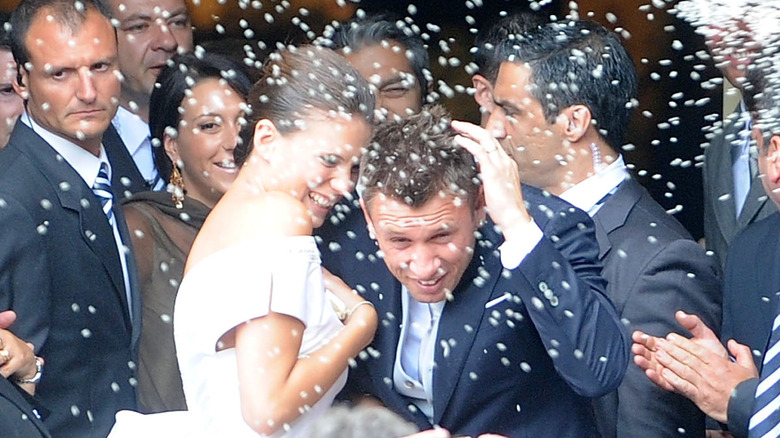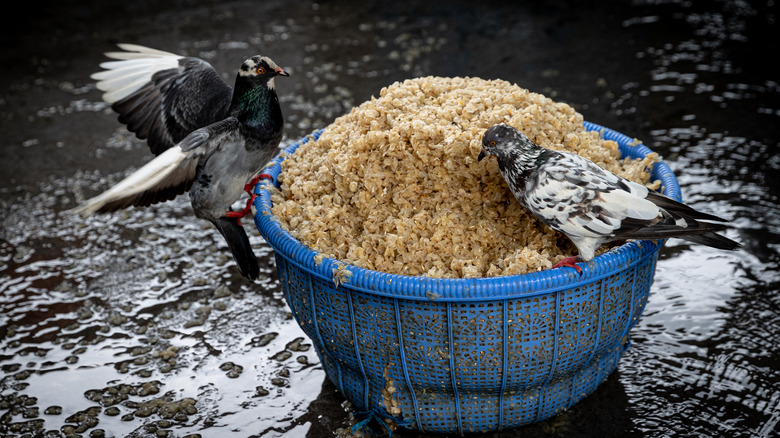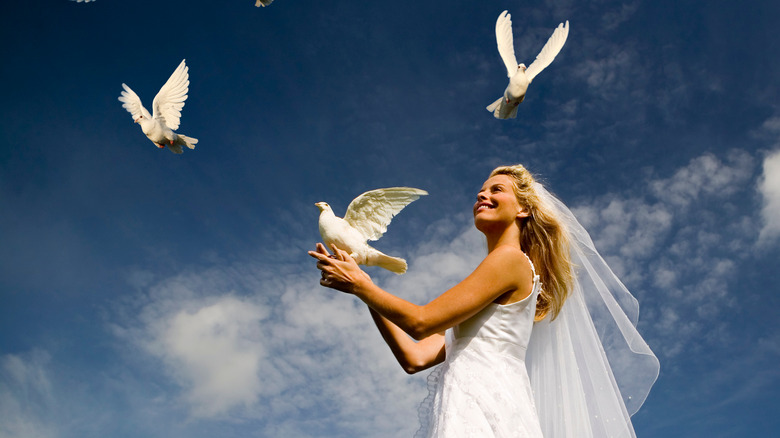Does Rice Really Make Birds Explode?
Traditions are hard to give up. Which is why it's funny that a little urban myth about bird safety halted a practice going back centuries.
Both the origins of throwing rice at weddings and the notion that said rice could expand in the stomachs of and kill wild birds are hard to determine. Currently, rather than dealing with the uncertainty of bloated birds littering their wedding site, modern couples keep the tradition alive with wedding rice alternatives such as bubble-blowing, or glitter, according to Celebrations LTD. Most alternatives aren't nearly as eco-friendly as rice — glitter, for instance. So, how did this rice tradition start, and is a change necessary? The origins of throwing rice at weddings dates back to an ancient Hindu tradition (per Richard Linthicum's 1903 work "The Educational Encyclopedia of Common Things"). It was meant to appease evil spirits and to encourage the fertility and prosperity of the happy couple.
Another potential origin goes back to around 1500 B.C., from a Chinese legend involving an ancient sorceress and the Golden Pheasant (via The Bendigo Independent, 1900). The story says that back in the Shang Dynasty, a sorceress was cursed with an inauspicious wedding day: "the day when the 'Golden Pheasant' was in the ascendant." To defeat this bird, the clever sorceress had rice thrown out the door of the wedding venue, distracting the monstrous spirit, and allowing her to pass to her bridal chair unharmed. It's ironic, then, that what was perhaps originally meant to appease a mythological bird is currently seen by many to be a blight on current bird populations.
Culture critics vs. bird scientists
We know the myth of exploding birds was perpetuated in popular culture by public voices such as longtime newspaper advice columnist Ann Landers (via Snopes) and Martha Stewart, in her book, "The Best of Martha Stewart Living Weddings" (via BioOne Complete). In 1985, Connecticut State Rep. Mae S. Schmidle took action. She was inspired by evidence from "several ministers who say that the next morning after a wedding, they see all these birds toppled over because they got poisoned by the rice" (via the AP). This was the impetus for a bill proposed to the Connecticut state legislature "prohibiting the use of uncooked rice at nuptial affairs." Avoiding the violent deaths of birds seems like a lofty enough goal.
Cue ornithologists, whose careers are the study of bird behavior and biology, losing their collective minds. "I have 50 years of professional experience as a practicing ornithologist and I've never heard of such a thing," said Roland C. Clement, the president of the Connecticut Ornithological Association about the bill (via the AP). He had the gall to suggest maybe some scientific evidence should be found before promoting the idea.
When Landers supported the explosive myth, Steven Sibley, an ornithologist and author, pointed out something he probably never thought he'd have to: "Rice must be boiled before it will expand" (via Bird Spot). Not only that, he went on to say that in birds, "powerful muscles and grit in their gizzards" would make short work of any rice. "Many birds love rice, as any frustrated rice farmer will tell you," he added.
The proof
So, other than ornithologists and farmers disagreeing with ministers in Connecticut, how do we know for sure this myth is false? In walks the hero of our story: James Krupa, professor of biology at the University of Kentucky. Per BioOne Complete, in 2005, he published a series of experiments testing the myth of birds eating wedding rice, the rice expanding, and the birds exploding. After painstakingly determining the power of expanding rice, seeds, and grains, the professor and students found even the most expansive rice of them all, instant white rice, would not harm pigeons and doves and "probably does not harm other species." No birds were exploded in the name of this scientific endeavor. His paper concluded that "the evidence strongly suggests the myth is false."
What Rep. Schmidle did not consider is that what she saw in her kitchen as cooked rice swelling to many times its original size was not going to happen in normal ornithological anatomy. Another consideration is that Krupa's experiments allowed the tested grains to expand for 24 hours, not the significantly shorter time it takes for bird digestion (via Bird Spot). As to why this myth periodically propagates, when the ornithologist Sibley corrected Landers, she graciously acknowledged her error: "Your letter proves once again that if a story is repeated often enough, people will believe it, even though it is false and defies logic" (via Bird Spot).


